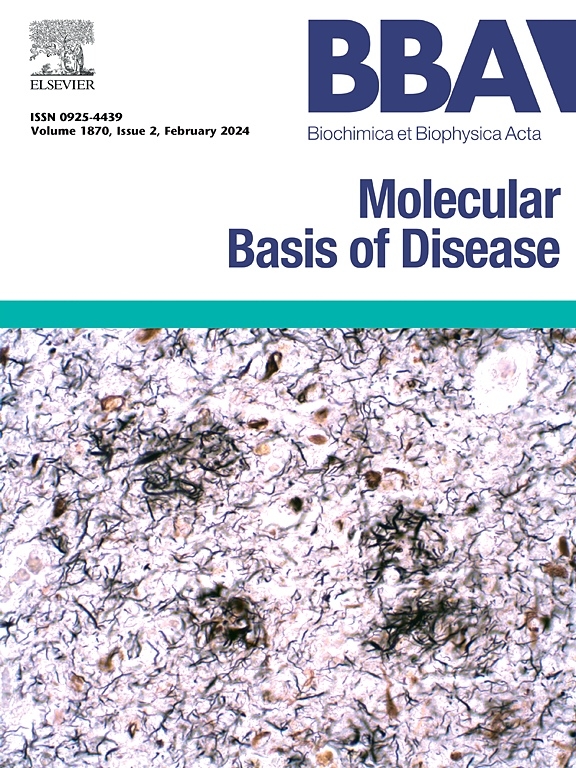高良姜通过抑制ros诱导的腺泡细胞凋亡和m1型巨噬细胞极化来预防急性胰腺炎。
IF 4.2
2区 生物学
Q2 BIOCHEMISTRY & MOLECULAR BIOLOGY
Biochimica et biophysica acta. Molecular basis of disease
Pub Date : 2025-05-02
DOI:10.1016/j.bbadis.2025.167887
引用次数: 0
摘要
急性胰腺炎(AP)是一种消化道常见病,其特点是血清胰蛋白酶升高和腹痛。急性美联社,特别是严重急性美联社,仍然是一种致命的疾病;因此,确定潜在的治疗方法并探索潜在的机制对AP患者至关重要。高良姜是一种从传统中草药中提取的类黄酮,在多种疾病中显示出强大的抗炎和细胞保护能力,但其在AP中的作用尚未揭示。我们通过小蛋白诱导小鼠、离体腺泡细胞和骨髓源性巨噬细胞模型,探讨高良姜对AP的作用及机制。采用组织学和免疫荧光染色对胰腺进行分析;测定各组细胞因子水平、淀粉酶和脂肪酶活性及活性氧(ROS)水平;流式细胞术分析浸润性巨噬细胞;对某些蛋白质和rna进行分析;并对高良姜的安全性进行了评价。我们发现高良姜通过nrf2依赖通路促进Srxn1表达,从而降低ROS和细胞凋亡,从而显著降低小鼠和腺泡细胞的AP。高良姜通过负调节NF-κB信号通路,显著减少浸润性巨噬细胞数量,抑制m1型巨噬细胞的活化。与对照组相比,高良姜治疗组未见明显副作用。因此,我们的研究表明高良姜是一种安全有效的治疗AP的药物,可以防止腺泡细胞损伤,抑制m1型巨噬细胞,提示未来治疗AP的潜在方法。本文章由计算机程序翻译,如有差异,请以英文原文为准。
Galangin protects against acute pancreatitis by inhibiting ROS-induced acinar cell apoptosis and M1-type macrophage polarization
Acute pancreatitis (AP) is a common disease in the digestive tract and is characterized by elevated serum pancreatic proteases and abdominal pain. AP, especially severe AP, is still a deadly disease; thus, identifying potential therapies and exploring the underlying mechanism are essential for AP patients. Galangin, a flavonoid extracted from traditional medicinal herbs, shows robust anti-inflammatory and cell protection abilities in various diseases, but its role in AP has not been unveiled. We explored the function and mechanism of galangin in AP using caerulein-induced mouse, isolated acinar cell and bone marrow-derived macrophage models. The pancreas was analyzed using histology and immunofluorescent staining; cytokine levels, the activity of amylase and lipase, and reactive oxygen species (ROS) levels were determined; infiltrating macrophages were analyzed by flow cytometry; certain proteins and RNAs were analyzed; and the safety of galangin was also evaluated. We found that galangin significantly attenuated AP in mice and acinar cells by decreasing ROS and apoptosis via the promotion of Srxn1 expression through an NRF2-dependent pathway. Galangin significantly reduced the number of infiltrating macrophages and inhibited the activation of M1-type macrophages by negatively regulating NF-κB signaling. Compared to the control, no obvious side effects were observed in the galangin-treated group. Thus, our study demonstrated that galangin is a safe and efficient drug to treat AP by preventing injury to acinar cells and inhibiting M1-type macrophages, suggesting a potential therapy for AP in the future.
求助全文
通过发布文献求助,成功后即可免费获取论文全文。
去求助
来源期刊
CiteScore
12.30
自引率
0.00%
发文量
218
审稿时长
32 days
期刊介绍:
BBA Molecular Basis of Disease addresses the biochemistry and molecular genetics of disease processes and models of human disease. This journal covers aspects of aging, cancer, metabolic-, neurological-, and immunological-based disease. Manuscripts focused on using animal models to elucidate biochemical and mechanistic insight in each of these conditions, are particularly encouraged. Manuscripts should emphasize the underlying mechanisms of disease pathways and provide novel contributions to the understanding and/or treatment of these disorders. Highly descriptive and method development submissions may be declined without full review. The submission of uninvited reviews to BBA - Molecular Basis of Disease is strongly discouraged, and any such uninvited review should be accompanied by a coverletter outlining the compelling reasons why the review should be considered.

 求助内容:
求助内容: 应助结果提醒方式:
应助结果提醒方式:


